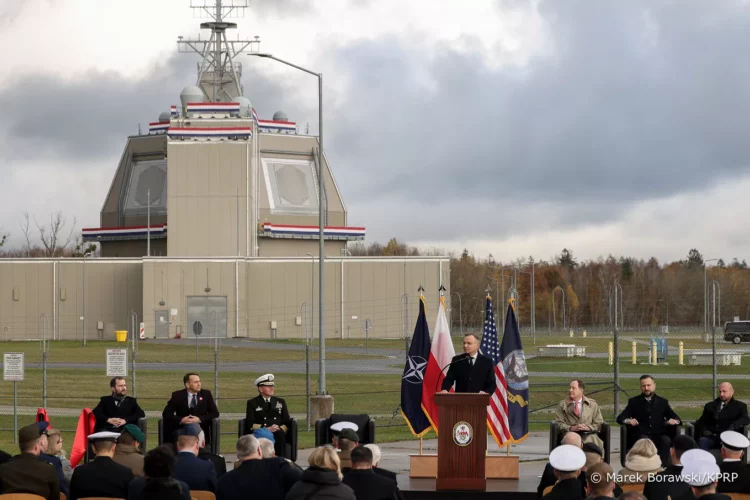Russia has intensified its rhetoric against NATO, declaring the U.S. missile defense base in Redzikowo, northern Poland, a “priority target” in a potential conflict. This stark warning, delivered by Russian foreign ministry spokeswoman Maria Zakharova on Thursday, underscores Moscow’s deep-seated opposition to NATO’s eastward expansion and the perceived threats posed by the alliance’s growing military infrastructure near Russia’s borders.
Zakharova criticized the newly launched Redzikowo base, calling its establishment a “provocative step” that increases nuclear risks. She accused the United States of using the installation to “project American power” and exert military pressure on Russia and other nuclear-capable nations, a strategy she claimed undermines global stability.
“This leads to increased strategic risks and elevates the overall nuclear threat,” Zakharova stated. She warned that Russia could target the base with advanced weaponry “if necessary.” The declaration highlights Russia’s ongoing concerns about NATO’s presence in Eastern Europe, which it views as a direct threat to its security and regional influence.
NATO and Poland Defend the Base
Polish and NATO officials were quick to respond to Moscow’s claims, emphasizing the defensive nature of the Redzikowo base. Polish foreign ministry spokesman Paweł Wroński dismissed Russia’s allegations as “absurd,” stressing that the base does not house nuclear weapons and is solely designed to intercept ballistic missile threats from so-called rogue states.
“Redzikowo is not an offensive installation; it exists to protect Europe and the United States from missile attacks originating from unstable regimes,” Wroński told the Polish state news agency PAP. He also pointed out that the facility aligns with NATO’s collective defense strategy, which seeks to safeguard member states against external aggression.
NATO officials echoed these sentiments, reaffirming their commitment to defending the alliance’s eastern flank. The Redzikowo base, managed by the U.S. Navy, is part of the American European Phased Adaptive Approach (EPAA), a program designed to protect NATO allies from ballistic missile threats, particularly from Iran.
“This installation strengthens our collective security and reinforces NATO’s deterrence posture,” Wroński added. “If Russia continues its threats, NATO will need to strengthen air defenses along the eastern flank to make such threats infeasible.”
A Symbol of NATO’s Eastern Strategy
The Redzikowo base officially began operations on November 13, marking a significant milestone in NATO’s integrated air and missile defense system. Located in northern Poland, the base plays a key role in deterring potential missile attacks and bolstering the alliance’s defensive capabilities in Eastern Europe.
As part of the EPAA program, the base is equipped with advanced radar and missile interceptor technology, designed to detect and neutralize incoming threats. While its primary objective is to counter ballistic missiles from Iran and other adversaries, the base has drawn sharp criticism from Russia, which sees it as a tool for extending U.S. military reach.
Polish Defense Minister Władysław Kosiniak-Kamysz recently hinted at potential upgrades to the Redzikowo facility, a move widely supported across Poland’s political spectrum. “There is widespread agreement in Poland that NATO’s eastern flank deserves the best possible air defense,” Wroński noted.
For Poland, the base represents more than just a military installation; it symbolizes the country’s integration into NATO’s security framework and its commitment to collective defense. The launch of the base is seen as a reassurance to Polish citizens and a warning to potential adversaries.
Rising Tensions Along NATO’s Eastern Flank
The Redzikowo controversy comes at a time of heightened tensions between NATO and Russia, fueled by the ongoing war in Ukraine. Since Moscow’s invasion in February 2022, Eastern European NATO members, including Poland, have increasingly become focal points for the alliance’s defense initiatives.
Poland has been particularly vocal about the need to strengthen NATO’s presence along its eastern border, arguing that the war in Ukraine has exposed vulnerabilities in the region’s defenses. The Redzikowo base, alongside other military installations, is part of a broader strategy to fortify NATO’s eastern flank against potential aggression.
Russia, however, views these developments as a threat to its security and has repeatedly lashed out against NATO’s activities. Moscow’s claims that the Redzikowo base could be used offensively have been dismissed by NATO as baseless, but the accusations reflect a broader mistrust that has defined Russia-NATO relations in recent years.
Zakharova’s comments highlight the increasingly combative tone of Moscow’s rhetoric, as well as its willingness to escalate tensions through threats and warnings. By labeling the Redzikowo base a “priority target,” Russia is sending a clear message: it sees NATO’s defensive measures as provocations and is prepared to respond aggressively if it feels its security is compromised.
The Path Ahead
As tensions persist, the Redzikowo base is likely to remain a flashpoint in NATO-Russia relations. For Poland and its NATO allies, the facility represents a crucial element of their defense strategy, particularly in the face of growing threats from both conventional and hybrid warfare.
However, the escalating rhetoric from Moscow underscores the risks of miscalculation in an already volatile region. While NATO continues to emphasize the defensive nature of its installations, Russia’s accusations serve as a reminder of the precarious balance of power in Eastern Europe.
Poland’s unwavering support for the Redzikowo base and its broader push for enhanced NATO defenses reflect the country’s determination to secure its borders and contribute to regional stability. Yet, as geopolitical tensions show no sign of easing, the challenge for NATO will be to maintain its deterrence posture while avoiding steps that could further inflame hostilities with Russia.
At the heart of the debate lies a question that has defined NATO-Russia relations for decades: how to ensure security and stability in Europe without escalating the risks of confrontation. For now, the Redzikowo base stands as a testament to the complexities and challenges of achieving that balance.


















